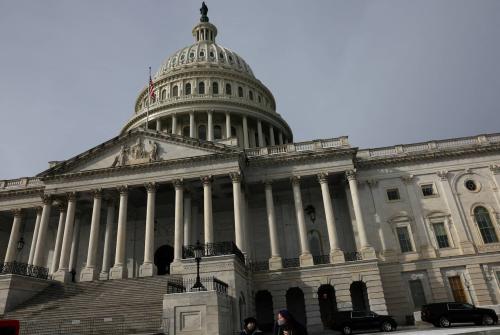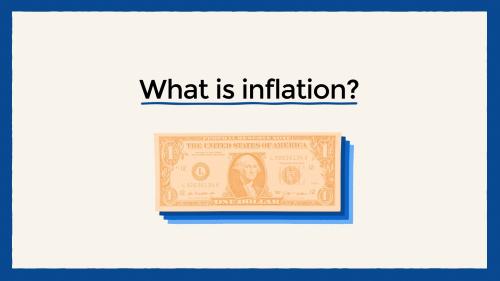This article is a summary of comments by participants in a public event, “What’s at stake in the 2024 election: Federal debt and the implications for government spending and programs,” hosted by the Brookings Institution and Miami Dade College on April 16, 2024. You can watch the full video here.
U.S. policymakers and the American public have expressed significant concerns about rising national debt, but there have been few meaningful actions in recent decades to address it. At an event co-hosted by the Brookings Institution and Miami Dade College, fiscal policy experts and local officials came together on April 16 to discuss the prospects for policies that can addresses concerns over rising public debt. You can watch the full video of the event here.
Setting the stage
Following a welcome from Miami Dade College President Madeline Pumariega, Brookings Institution President Cecilia Rouse took the stage to detail the challenge of the rising national debt. Rouse explained that, beginning after the 1990s, federal spending has far outpaced revenues, leading to persistent annual deficits. To accommodate these deficits, the federal government “borrows” by issuing Treasury bonds, which must be paid back with interest. The cumulative impact of these deficits is what makes up the national debt, Rouse explained, which today stands at about $27 trillion. That number puts the debt at about 100%, far above the roughly 30% debt-to-GDP ratio in the U.S. in the 1970s and the current ratio of most other OECD countries, Rouse said.
Much of the rise in the national debt is attributable to an aging population, said Rouse, with 18% of the population over 65 today, up from 12% in 1983. As the baby boom generation has entered retirement, the amount the government spends on services like Social Security and Medicaid has risen. In addition, a series of tax cuts starting in 2000 have contributed significantly to the lack of revenue, explained Rouse, with cuts under both Republican and Democratic presidents contributing approximately 50% to the rise in debt relative to GDP.
With the background on the national debt laid out by Dr. Rouse, the question of how to address it was taken up by an expert panel: Ben Harris, vice president and director of the Economic Studies program at Brookings; Oliver G. Gilbert, III, chairman on the Miami-Dade County Board of Commissioners; and Douglas Holtz-Eakin, president of the American Action Forum, with Betty Nguyen of CBS News moderating. Below are a few takeaways from their discussion:
The risks are real
Ben Harris opened the discussion with his perspective on the uncertainty of risks posed by a rising and unchecked national debt. “There’s a decent chance that in my lifetime, this will not become a huge issue,” Harris said. “There’s also a decent chance that in the next 2 or 3 years it will blow up our whole economy.” Among the primary concerns Harris noted, a rising national debt could lead to significant financial market consequences, including investors steering away from U.S. Treasuries and credit downgrades (like one that already happened in 2023).
Holtz-Eakin offered another perspective: While financial disaster is a potential consequence of the high national debt, there is another that we are already experiencing, which is the slowed improvement in American standards of living. “Access to the American dream has gone from one working career to going over the horizon, and people feel that,” said Holtz-Eakin. “There’s a palpable sense of not having the same opportunities we had before. I believe a lot of that is the headwinds provided by debt.”
From a local view, Chairman Gilbert said that everyday citizens will feel the effects of the debt when it comes to things like higher interest rates and the ability to purchase houses, but until those consequences show up, the conversation about the debt is too mired in politicization rather than our national priorities.
Better to act now than later
All the panelists agreed that when it comes to Congressional action to alleviate our national debt burden, it is better to act sooner rather than later. Holtz-Eakin put special emphasis on ensuring Social Security solvency, which, as Dr. Rouse noted in her keynote, will be a large and growing cost for the U.S. government as the population ages. On an individual level, Holtz-Eakin argued that a solution for Social Security is necessary for those trying to plan for retirement. Even though he is confident that Congress will eventually find a solution, that uncertainty is a major burden to put on those looking to plan for retirement currently. This is especially true, Harris noted, because changes to such a large, complex program take years: “We’re still seeing the effects today … of a reform that was made in 1983. These are decades-long solutions and waiting until the very end is wildly irresponsible,” he said.
These concerns are urgent in South Florida, said Chairman Gilbert, because it’s a part of the country with a large retired community. And even for those who aren’t yet retired, revenue shortfalls at the federal level have local impacts when it comes to federally funded jobs and education. “No problem that you can solve this year will be easier to solve next year,” said Gilbert. “That’s not the nature of the economy, that’s not the nature of the problems that we face.”
It’s not a hard arithmetic problem, it is a hard political problem.
Douglas Holtz-Eakin
What can we do about it?
Turning to solutions, Harris highlighted two key areas. First, he argued for closing the “tax gap”—the gap between what Americans owe in taxes versus what they actually pay, which amounts to roughly $700 billion each year. Reversing the pre-Biden administration trend of declining funding for the Internal Revenue Service (IRS) could help close that gap. Holtz-Eakin added that tax law could also be revamped to raise more money without affecting the economy, which will be a major issue in 2025 when many of the 2017 Tax Cuts and Jobs Act provisions expire.
Second, Harris returned to Social Security. In 1983, 90% of wages were subject to the Social Security tax, said Harris. However, the share of wages that are subject to the payroll tax have been in long-term decline. Raising that wage cap wouldn’t be a permanent solution, but it “would buy us… decades in terms of Social Security solvency,” said Harris. It would also help alleviate the burden of the program on annual deficits, Holtz-Eakin said, adding, “It’s not a hard arithmetic problem, it is a hard political problem.”
-
Acknowledgements and disclosures
The Brookings Institution is financed through the support of a diverse array of foundations, corporations, governments, individuals, as well as an endowment. A list of donors can be found in our annual reports published online here. The findings, interpretations, and conclusions in this report are solely those of its author(s) and are not influenced by any donation.





Commentary
What can be done about the high and rising national debt?
Takeaways from a Brookings-Miami Dade College event
April 23, 2024